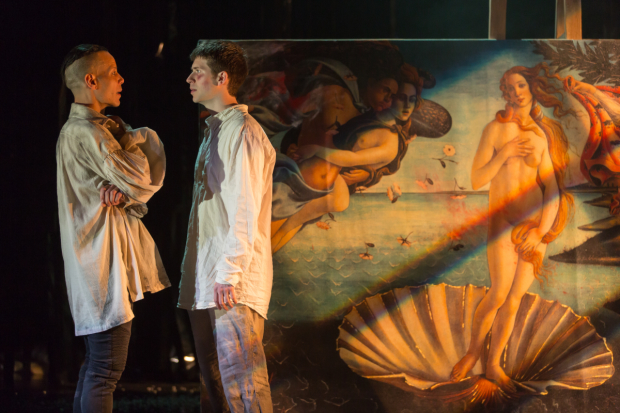Botticelli in the Fire Revisits the Life and Loves of a Renaissance Artist
Woolly Mammoth Theatre examines the past and the present through art in this world premiere.

(© Scott Suchman)
The current play at Woolly Mammoth Theatre, Botticelli in the Fire, is a world premiere by Canadian playwright Jordan Tannahill. Its cast of characters is an art historian's dream: Sandro Botticelli; Leonardo da Vinci; Lorenzo de Medici; his wife, Clarice Orsini; and the ultraconservative friar Girolamo Savonarola, to name a few.
But Tannahill does not tell the story as conventional history. Instead, he envisions Botticelli coming back from the dead to set the record straight, turning history on its head to draw comparisons between America today and Florence in the late 15th century, when a conservative leader and a religious hothead successfully attacked and destroyed artists and intellectuals. One event of that oppressive era was the massive burning of books and artworks in 1497, an event known as the bonfire of the vanities.
The play begins with a tipsy Botticelli (Jon Hudson Odom) guzzling a bottle of wine. When he introduces himself, it's clear that his ego is massive and he believes he can do no wrong. But Botticelli's ease with his own personality and body make him instantly likable. When he is met onstage by friends da Vinci (James Crichton) and Poggio du Chullu (Earl T. Kim), who have come to join him at a ball in his honor, it's clear that Botticelli is the man of the hour. He's also walking a tightrope without a net. Gleefully pansexual, Botticelli's mistress is Clarice (Alyssa Wilmoth Keegan), the wife of his patron, de Medici (Cody Nickell). And he is also attracted to his new assistant, da Vinci.
The acting in Botticelli is superb, particularly Odom, who plays Botticelli as a very complicated man, with all the power that character deserves. Odom's Botticelli admits to feeling admiration as well as love for da Vinci, making him seem as human as he is self-centered. He is vaguely androgynous and utterly propelled by the erotic. Crichton is brilliant as da Vinci: shy, quiet, but full of passion for art and for Botticelli. Nickell is frighteningly true to life as Botticelli's smooth-talking patron, the ruler of Florence who punishes Botticelli severely for sleeping with his wife. Nickell is best in a scene where he also gets to show off his athletic prowess as he and Botticelli play squash.
Keegan is excellent as the self-assured Clarice. Whether she is enjoying sex with Botticelli or appearing in a mock representation of Botticelli's most famous work, "The Birth of Venus," Keegan illustrates a persona rare in Renaissance Florence: a straightforward woman ready to express her extreme hatred for her husband. Dawn Ursula is delightful as Botticelli's mother, particularly in a scene where she sits on the floor to wash her son's body, mimicking Botticelli's many "Madonna and Child" paintings. Craig Wallace is impressive as Savonarola, although it is an underdeveloped part and wastes Wallace's major talent.
Set designer Misha Kachman lines the ceiling of the Woolly Mammoth stage in gold crown molding with wide, black plastic strips descending from it. The stage is generally used as Botticelli's studio, where an easel supports his huge, unfinished "Birth of Venus" canvas, which faces away from the audience. The lighting by Colin K. Bills is stunning, particularly in a scene where Botticelli stands outlined by the angry red light of Florence in flames. Ivania Stack creates costumes that are part-Renaissance, part-modern play.
As Marti Lyons directs the play, it moves smoothly and swiftly, and Lyons emphasizes the comedic presence of the play's many anachronisms. Botticelli tells four stories: one about Botticelli's addiction to beauty, one about his attraction to Clarice, one about his love for da Vinci, and one about the bonfire of the vanities. As a result, the play seems to continually hesitate, starting and stopping again and again. More problematic, Botticelli must make two choices in the course of the play, one affecting his art, one affecting da Vinci. Neither decision seems credible as written. Still, the play describes well the intensity of the times it portrays — both then and now.









